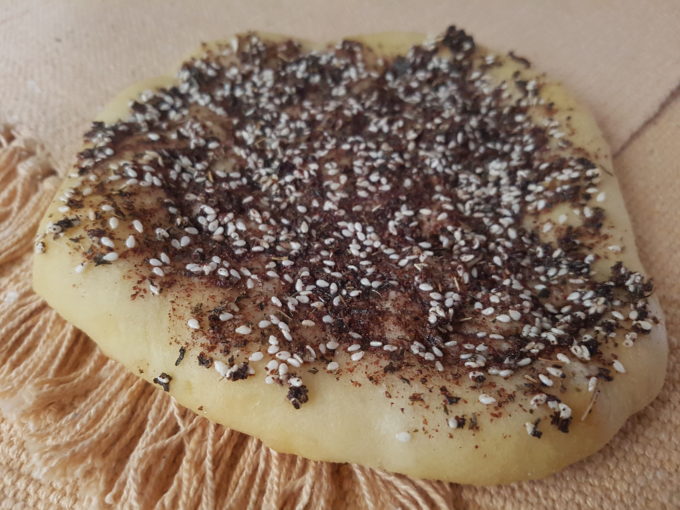One of the things I love about cooking new Asian foods is learning how to translate their names. Nori Komi took me a while to figure out. Not the nori part. That’s really easy; ‘seaweed.’ To be specific it’s a type of seaweed, nori. But the komi part took me a while to track down. […]
Read moreThe base for any furikake is sesame seeds and salt. The name noritama comes from nori, or ‘sea weed,’ and tama, short for tamago, which means ‘egg.’ This ‘sprinkle’ for rice is hugely popular not only in Japan but all over the world. Noritama furikake is easy enough to purchase, even common in many US […]
Read moreNot too long ago I spend considerable amount of time studying the Za’atar blends of various regions. Besides the most common use as a dip for olive oil and bread, Za’atar is also regularly used to season tomatoes. Although I don’t have the ability to get a hold of the true za’atar fresh herb I […]
Read moreManakish, pronounced manakeesh, is a very popular flat bread from the Middle East. It is most commonly topped with a za’atar blend, but can also be found topped with tomatoes, local cheeses, ground seasoned lamb, chilies, or greens. It can be sliced or served whole, and eaten flat or folded. Manakish is common for both […]
Read moreA few years ago, when we were just starting this food adventure, I created an olive tapenade recipe. It wasn’t a bad recipe, though I certainly needed to update the photos! It was just very simple. This week I realized how much I have grown in the culinary field when I decided to clear out […]
Read moreThis sauce is a SUPER EASY staple to have in your repertoire. Perhaps you’ll measure for the first few times you make it, but soon enough you will find that you can easily toss together a rough proportion, or even experiment with some of your other favorite flavors, (try adding ginger or substituting ponzu!) for […]
Read moreSigeumchi-namul 시금치나물, from sigeumchi for spinach and namul because it is a vegetable dish, is one of the most common banchan (Korean side dish), and also one of the easiest! Best of all it isn’t spicy, so everyone can enjoy it! It’s funny to me that even as a family that isn’t particularly fond of […]
Read more“What is the Korean name for this dish?” you ask. Well that depends on what kind of bean sprouts you use. First and foremost this dish is a namul (나물) , referring to a steamed, stir-fried, or marinated vegetable dish. However, sukju-namul is the name for bean sprouts in general. Now soy bean sprouts are […]
Read moreOi-muchim (오이무침): oi for cucumber and muchim for mixed or tossed, this quick Korean side dish is very common as a snack and of-course a banchan for any meal or special bapsang. (Sometimes it is also written as Oi Saengche (오이생채) from the Chinese influenced Korean writing for live vegetable since it is not ‘dead’/cooked.) […]
Read moreOjingeo means squid, and chae means shredded or julienne so Ojingeochae (오징어채) is dried squid strips, and then you add muchim (무침) meaning mixed to title the dish. As the second half of the name implies the sauce and the dried squid strips, (already processed with salt and sometimes sugar,) are simply mixed together and […]
Read more









